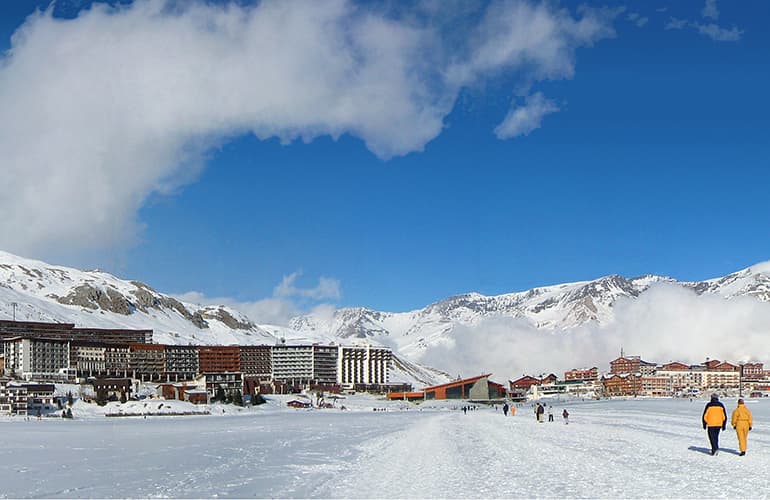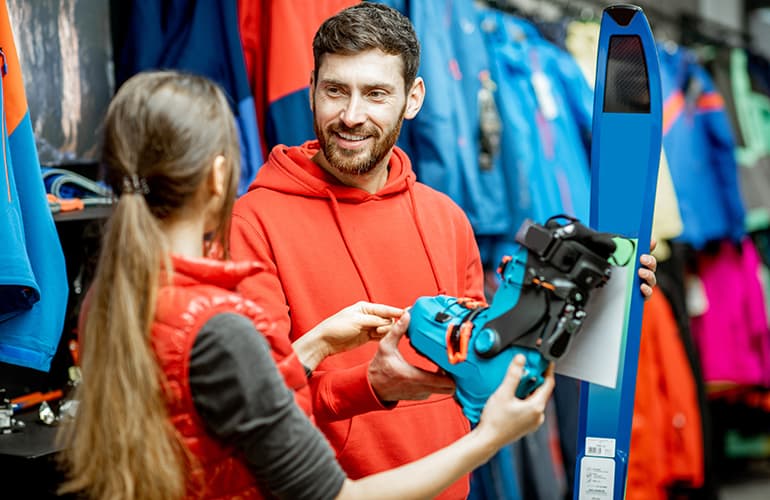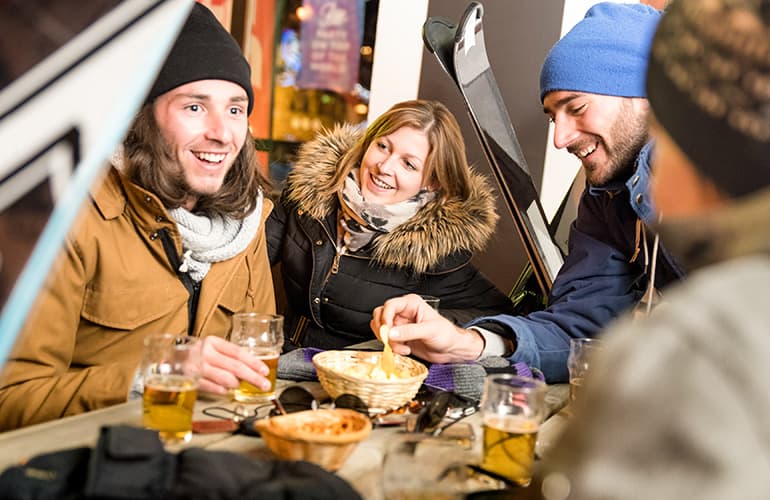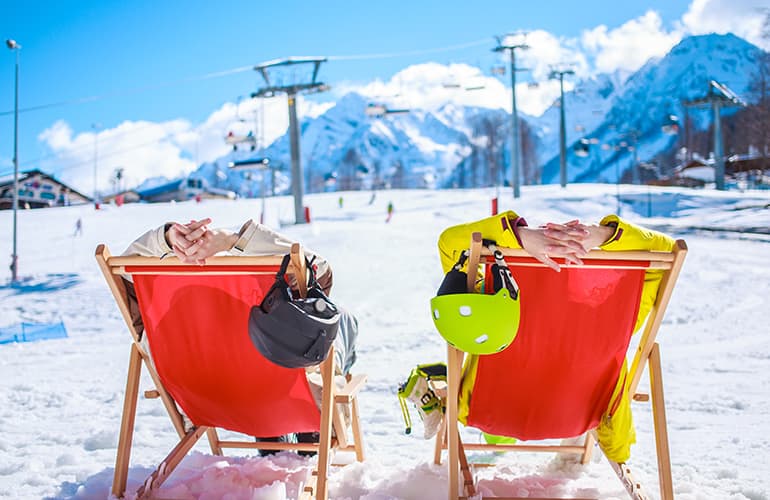Whether you’ve been skiing since before you could walk, or you’re planning your first foray onto the slopes, our ultimate ski holiday checklist will have you covered and make sure you have everything you need.
After counting down the months, weeks and days until your next skiing holiday, it’s finally time to start packing. Even if you’re an experienced skier, amid all the preparation, it’s easy to overlook something vital while packing and spend your trip regretting it. It will always be more expensive to buy ski gear, clothing or gadgets at the resort than at home.
Take the stress out of your preparations with our ski holiday checklist.

If you can’t wait to hit the slopes, Tignes has some of the best early season skiing
Ski checklist #1: Travel essentials
Along with all the usual essentials like passports, currency and smartphone, make sure these are in your wallet or hand luggage:
- Travel Insurance documents – always keep your paperwork somewhere safe and accessible. Accidents can happen on the slopes!
- Passport photos – in case you need them for your lift pass
- UK Global Health Insurance Card (formerly known as European Health Insurance Card)

It’s a good idea to speak to an expert in store before purchasing any equipment
Ski checklist #2: Ski clothing
If you’re a seasoned skier these will be the things you will have laid out on the bed for several months, just waiting for the day that it is officially acceptable to start packing!
- Ski jacket – or any warm, waterproof and breathable jacket
- Salopettes – these should also be warm, waterproof and breathable
- Ski gloves – or mittens if you prefer
- Ski socks – at least three or four pairs for the trip
- Glove liners – for when it’s very cold
- Balaclava – essential for extremely cold conditions
- Neck warmer – the more layers the better, really
Ski checklist #3: Ski gear & equipment
If you’re a beginner you might want to hire your ski gear at the resort – it saves a lot of space in your luggage or car and does not burden you with equipment if you decide skiing isn’t for you.
All the equipment you need can be hired at the resort and it’s easy to book a slot to go and collect it when you arrive. If you do decide to invest in your own equipment, it’s a good idea to go into a specialist store rather than purchase it online as you need to be fitted into your boots and skis by providing the store details of your ski level, weight, height and shoe size.
- Skis or snowboard – you’re not going to get very far without these!
- Ski poles – don’t forget to take them with you to and from the slopes
- Ski boots – make sure they fit properly, or you’ll be incredibly uncomfortable
- Ski helmet – make sure you get it professionally fitted. These can be hired at the resort
- Ski goggles – it’s difficult to rent these, so it’s worth investing in a pair before you go. A pair with interchangeable lenses is a good idea due to the variability of the weather conditions
Ski checklist #4: Other clothing
Get these on your ski holiday Christmas list!
- Warm knitwear – layering is key, and natural fibres tend to be best
- Warm socks – bring more than you think you’ll need
- Base layers – it’s up to your preference of traditional thermals or modern layers to go under your ski jacket
- Gloves, scarves and hats – remember it’s cold even when you’re not up a mountain
- Comfy shoes – there’s no need to exacerbate any blisters you might get from your boots
- Wellies – or other suitable waterproof footwear
- Slippers – for padding around your chalet
- Swimwear – in case you fancy a dip in a hot tub
- Jeans, t-shirts and tops – for après-ski and evening entertainment
- Coat – you may not always want to wear your ski jacket

Make sure you’re ready for anything, both on and off the slopes!
Ski checklist #5: Toiletries, health & medication
- First aid kit – make sure it’s well stocked with all the essentials
- Toiletries – deodorant, toothbrush, toothpaste, shampoo, hand sanitiser, etc
- Deep Heat – your aching muscles will thank you for this one
- Sun cream and lip block - absolutely essential, as the UV rays of the sun on snow is very high. Make sure you bring a high factor
Ski checklist #6: Electronics
No skiing checklist is complete without the little gadgets that keep your devices topped up.
- Power banks or external battery packs
- Travel speakers, headphones, tablets
- GoPro camera – for those YouTube moments
Ski checklist #7: On slope essentials
Don't forget the following in your ski holiday checklist - they could come in handy or get you out of a hole (literally)!
- Lift pass – check and check again that you have this on you
- Avalanche transceiver, shovel and probe – essential if you’re heading off piste
- Map and compass – so that you can always work out where you are
- Multitool knife – you never know when you might need a blade or tools
- Hand warmers – cold fingers make everything so much more difficult
- Sunglasses - the snow glare is very strong. You will certainly look the part!
- Ankle, knee or wrist supports – in case you need extra support or strain something
- Water – always stay well hydrated
- Snacks – for a little pick-me-up energy boost
 Make sure you have all the essentials while on the slopes
Make sure you have all the essentials while on the slopes
When and where to ski
As far as Europe goes, the ski season doesn’t really kick off until December, but if you find yourself unable to wait that long, you can still hit the slopes in the early season during October and November. In Austria, the glacier areas of Sölden and Stubai have been known to open as early as September, providing the conditions allow it.
Generally, early season skiing is limited to Austria and Switzerland and can be a bit hit-and-miss due to the unpredictability of the weather.
If you do manage to get lucky with an early snowfall, however, you’ll benefit from much quieter slopes. It also tends to be cheaper in the early season in the French Alps, for both accommodation and lift passes. You may even be lucky enough to spot national ski teams in training, as they like to get out there as early as possible and will drop everything for that first dumping of fresh powder.
 You can rely on Val Thorens for early season snow
You can rely on Val Thorens for early season snow
Where to catch the early ski season
In France, Val Thorens is noted for having some of the most reliable mountains as the altitude means snow can be made both manually and artificially. Tignes is the only resort to open at the start of October and is considered one of the most reliable areas for early snow. It’s suitable for all levels of skiers and snowboarders, catering to everyone from beginners to experts in equal measure.
From December, it’s a different story, with ski resorts all over Europe open for business, welcoming skiers and snowboarders right up until April, so there’s plenty of opportunities to carve up those slopes.
Tips for successful ski holiday packing
A general rule of thumb for skiing is that it’s always better to be over-prepared rather than under-prepared, so when it comes to things like socks, always take more than you think you’re going to need.
The amount of clothing and equipment needed for a skiing holiday means that driving to your resort gives you an immediate advantage. There are no restrictions or fees on luggage when travelling with LeShuttle, so you can load up, hit the road and enjoy more quality time on the slopes

Prepare yourself for the ultimate skiing holiday
Don't worry about packing light with LeShuttle
Can you feel the slopes calling? If you’re already mentally packing your bags and loading up the car, don’t forget to book your tickets with LeShuttle. We can help you make the most of your skiing holiday with driving guides, and articles that give you the lowdown on resorts like La Clusaz, Livigno and La Rosière.